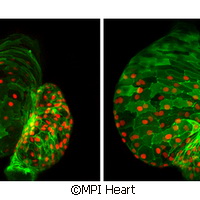Scientists find key protein in embryo cardiac development
Two main problems impact the development of the heart in the embryo: it is no easy process and errors are bound to surface. Scientists in Germany may have succeeded in solving the mystery behind why babies are born with congenital heart defects. The Max Planck Institute for Heart and Lung Research researchers have discovered a molecule that helps regulate the function of stem cells in the heart. Their finding could help researchers curb the number of heart defects in the future but it could also lead to novel methods of stimulating the regeneration of damaged hearts in adults. The process of going from point A to point Z in the development of a heart is long. Cells divide and transform into a collection of only a few cardiac stem cells, and then into a larger structure from which the heart's parts, including the atria, ventricles, valves and coronary vessels, develop. Basically, stem and precursor cells undergo a complex process that comprises regulated cell division, cell migration, differentiation and specialisation. The stem cells switch off when the heart's development is complete. In their study, the Max Planck Institute researchers identified how key parts of this development process are regulated. They first put the spotlight on finding binding partners for transcription factor lsl1, which is characteristic of a specific group of cardiac stem cells called lsl1+cells. In their investigation, the team found Ajuba, a transcription factor from the group of LIM proteins. 'We then took a closer look at the interaction between these two molecules and came to the conclusion that Ajuba must be an important switch,' said Gergana Dobreva, head of the 'Origin of Cardiac Cell Lineages' Research Group at the Max Planck Institute for Heart and Lung Research. The team evaluated the effects of a defective switch on cardiac development of zebrafish and generated a genetically modified fish that was missing a functioning Ajuba protein. According to the researchers, the heart's development of the zebrafish was disrupted. They also observed a difference in heart size. 'In almost all the investigated fish we observed a dramatic enlargement of the heart,' Dr Dobreva said. 'If Ajuba is absent, there is clearly no other switch that finally silences the Isl1-controlled part of cardiac development.' In addition, they found that the heart is bigger because there are more cardiac muscle cells. The team suggests Ajuba plays a key role in regulating stem cell activity; it binds to Isl1 molecules and blocks their stimulant effect. 'Once we understand how cardiac development is regulated, we will also be more familiar with the causes of congenital heart defects and will consequently be able to consider therapeutic approaches,' Dr Dobreva commented. 'One possibility would be to optimise the production of replacement cells from embryonic or artificially produced stem cells in the laboratory. Silencing Ajuba in these cells might enhance their development into functional cardiac muscle cells. Sufficient replacement cells for treating patients could be cultured in this way.'For more information, please visit: Max Planck Institute for Heart and Lung Research: http://www.mpi-hlr.de/index.php?id=start0&L=1
Countries
Germany

